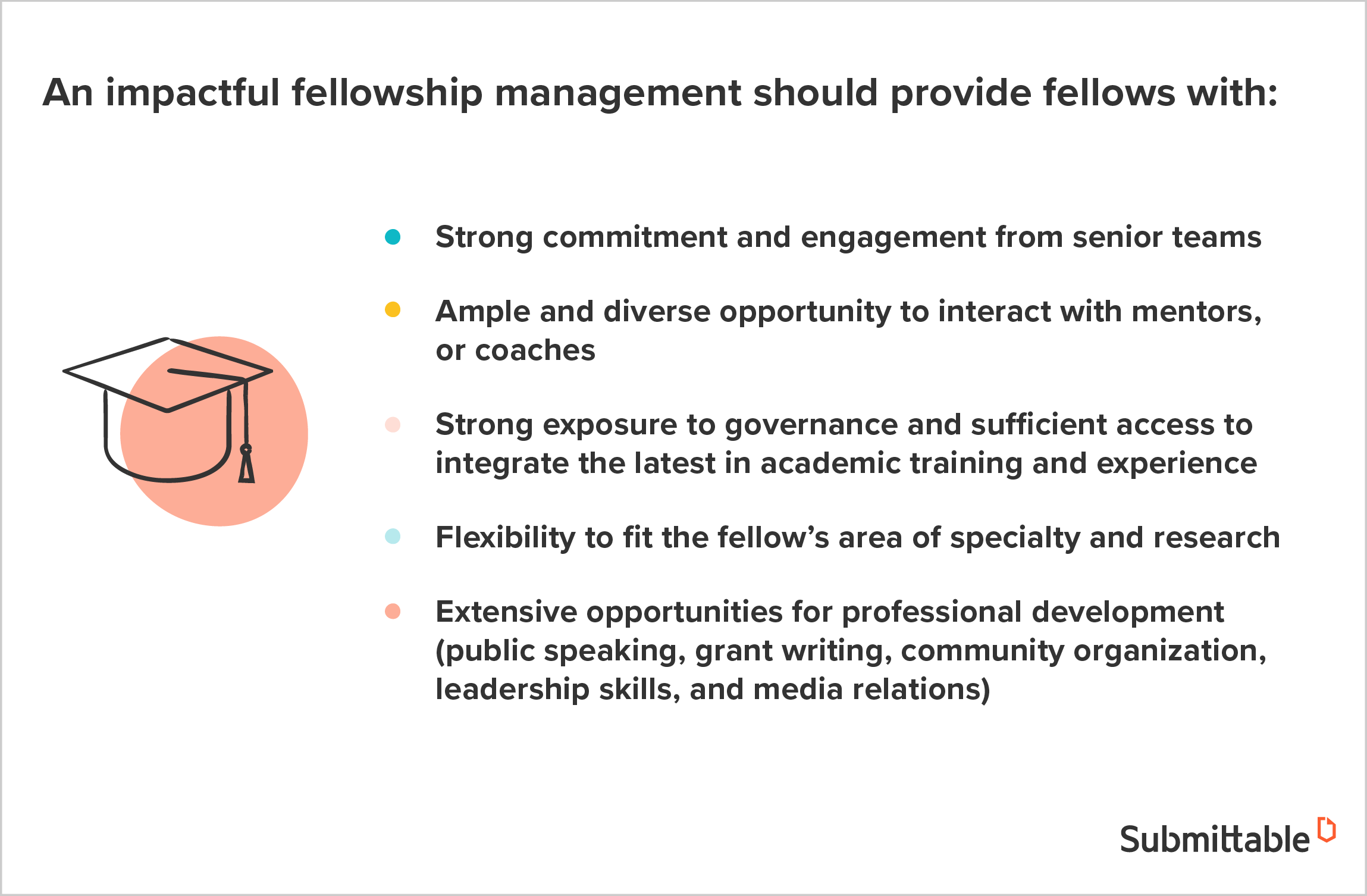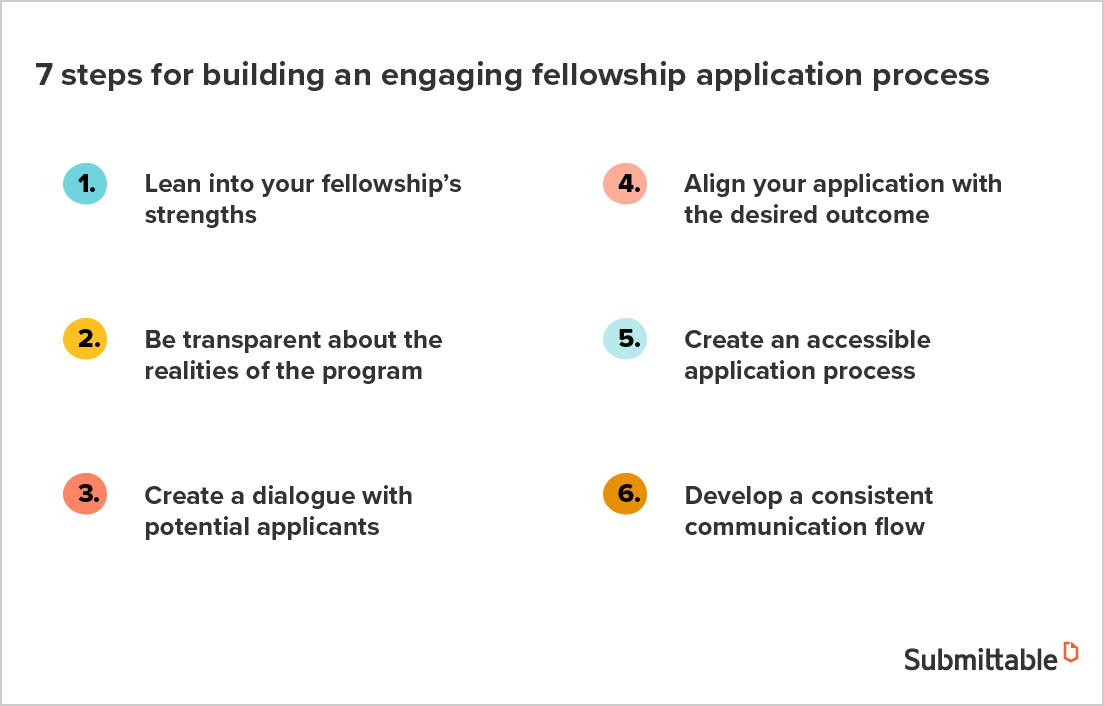The competition for fellowships can be fierce.
And it cuts both ways. Applicants often feel intense pressure to put their best foot forward and stand out from other students. Likewise, organizations are locked in a battle for top talent—hoping to attract the best minds to showcase their program to its fullest potential.
Many fellowship program applications are built with administrators and reviewers in mind—and that makes sense because you want your process to be simple and efficient on your end. But it’s vital not to forget that the process matters to applicants, too. This is after all, all about them—their education, their goals, and their dreams.
You’ll need to create an application experience that considers the perspective of the applicant and engages them at every step—to stay competitive with other program and to stay competitive with applicants.
Before we go into specific steps to building an engaging application process, let’s look at what makes an impactful fellowship program.
What makes an impactful fellowship program?
Every fellowship is an opportunity: for the school to secure a bright mind and for the student to secure a bright future.
There are several factors you’ll need to consider when building your award or awards:
- Will the fellowship grant cover the cost of tuition only, or will it fund scholarly activities outside the classroom?
- Will the grant cover dissertations or thesis projects?
- Travel to conferences?
- Cost of living?
Regardless of the size and scope of your program, there are a few variables that should resonate across all fellowship grants, and it’s what candidates measure when making their decision.

The most successful fellowship programs focus on driving impact across 5 key areas:
- Commitment
- Interaction
- Exposure
- Flexibility
- Opportunity
For each facet, you have an opportunity to highlight the relative strength of your program versus those competing for the same applicants.
When it’s time to put the call for submissions out to the public, the quality of your application process is also going to make an impact. And communicating how your program stacks up across these dimensions is the key to attracting the most talented students.
Applying for a fellowship program isn’t an easy task, and it requires significant time and energy investments from applicants. If the application process is complicated and disengaged, it easily becomes a cumbersome task to get through. Some might not even begin. When faced with multiple programs, students may choose only certain processes to even engage with in the interest of time.
Let’s walk through six actionable steps to building a fellowship application process that’s both efficient and engaging.
7 actionable steps for building an engaging fellowship application process

1. Lean into your fellowship’s strengths
Based on the 5 factors above, you should highlight the elements that make your program unique. Your fellowship may not be superior to competing programs in every aspect. But that’s okay.
The key to differentiation is leveraging your strengths.
Rather than trying to compete with other programs on the aspects that make them successful, differentiate your fellowship by leaning heavily into your own strengths. This could mean emphasizing the flexibility of the program, its hands-on nature, or the plethora of mentors that are available.
Whatever your program’s relative strengths, use them.
Make sure that your application and communications are aligned around a clear message about what makes your fellowship the best option and for whom.
2. Be transparent about the realities of the program
In pursuit of promoting something we care about, it’s easy to overindulge.
We want to hype up the best parts of the program (and you should). But you can also use a dash of reality to ground the expectations and make sure that they align with the vision and the expectations of the applicants.
Don’t sell your program short–but be transparent about the functional reality.
The key here is that you want to provide an authentic vision for what a fellow may feel and experience in the program.
Yes, you can expound on the loftier visions and ethos behind the fellowship. But, you should also paint an accurate picture for what the day-to-day might look like for those who are accepted.
What are the expectations? What is the environment like? How will the program roll up into the broader academic workload?
Communicate these elements in a transparent way to set the bar for applicants.
3. Create a dialogue with potential applicants
Applicants for your fellowship program are likely to have a lot of questions. They want to get a full picture of what the program will entail and the impact it will have on their future and their careers.
But not every applicant will have the same needs or expectations. It’s best to take a comprehensive approach that opens up a dialogue.
Institute several practices to create opportunities for a wide range of applicants:
- Invite alumni and current fellows to share their experiences
- Create content, blog posts, and videos that answer the most common questions
- Schedule time for Q&A through conference calls, webinars, and office hours
- Use email, live chat, and social media to engage one-on-one with interested students
Also be sure that your application and other materials are accessible to those with disabilities. Not only is it the right thing to do, it’s also the best way to get the best possible candidates to apply. Learn more about building accessible forms here.
4. Align your application with the desired outcome
Many organizations use standardized applications and boilerplate language in their fellowship applications.
But are these requirements truly aligned with the stated goals of the program?
Chances are that you can attract better-fit applicants and enrich your selection process by rethinking the application itself. Be creative with the materials, media, and information that you collect from applicants. Create space for each student to showcase their full range of talents and accomplishments.
Consider what’s being captured in your current application and what’s missing:
- Do the application requirements advantage certain applicants over others?
- Is there room for each student to highlight their own abilities?
- What additional context could lead to a more equitable selection process?
- How do your application requirements reinforce (or restrict) applications from the best-fit students?
- Have changes in technology or circumstances been factored into the current application?
5. Create an accessible application process
Compiling a strong application for a fellowship program takes significant time and effort, and for many, finally sending it off can leave feelings of nervousness and anxious anticipation.
Let them know what’s happening to their application by providing a way to track it, and more importantly, making it easy to do so. You can do this by using a fellowship management platform that guides candidates through the entire application process, without the need for emails, letters, or phone calls to administration.

This is also a boon for staff and administrators, who will have a unified system for receiving and reviewing applications as well as communicating with applicants.
6. Develop a consistent communication flow
One of the most anxiety-ridden stages of the fellowship process is the black box that exists between submission and acceptance or rejection.
Your organization can develop a standard communication workflow that automatically sends updates to applicants as they move through the submission and review process.
Consider developing messages for each stage, such as:
- Application submission confirmation
- Application entering initial review
- Peer or panel review
- Interview selection
- Final selection committee
- Rejection
- Acceptance
In each message, you have the opportunity to further engage the applicant, provide feedback, and establish context.
Ideally, the applicants will already have a strong sense of how the process will unfold. So, each communication allows them to track their application’s progress.
Creating an engaging fellowship application with a submission platform
Using the right fellowship management system can speed up the lengthy stages of the process, simplify the communication routes, and keep applicants informed and engaged throughout the cycle. You can make it easy and engaging for candidates by sharing a vision of the invaluable experience that awaits them while relieving them of the added burden of typical application processes.
And it’s not just gold for applicants—administration teams that use Submittable have reported time savings of up 10 hours per week. You can boost your fellowship program’s reputation, engage more candidates, all while helping your review committee modernize their systems. Now that’s a win-win.

